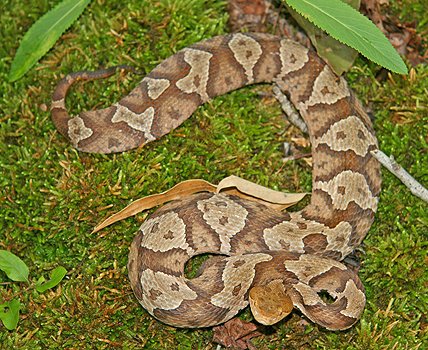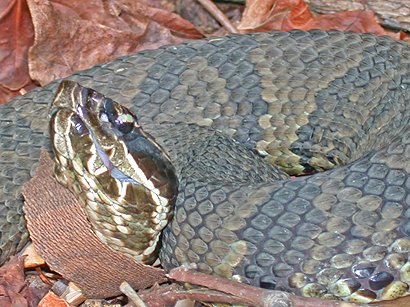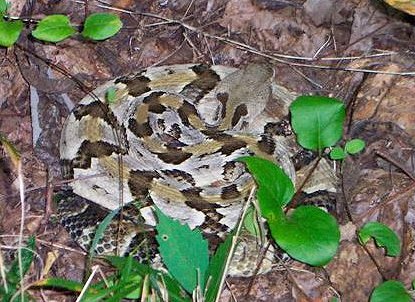When most people see a snake the first question they ask is ‘ Is it poisonous?’ Technically snakes are classed as venomous or non-venomous, since poison is ingested or absorbed and a venom is injected. But identifying venomous snakes in Tennessee is relatively easy since they all belong to the pit viper family. To see a list of Tennessee’s snakes click here. Below are some tips to help distinguish between venomous and non-venomous species in Tennessee.
All of the venomous snakes native to Tennessee belong to the family of snakes called pit vipers. Pit vipers are the group of venomous snakes having a specialized, heat sensing pit on the front of the head. There are four species of pit vipers in Tennessee: Copperhead, Western Cottonmouth, Timber Rattlesnake and the Western Pigmy Rattlesnake.
All of our venomous snakes have a vertical, elliptical shaped eye pupil. They are generally heavy bodied animals and because of this are not very good climbers. They are ovoviviparous, meaning they retain the eggs within the body until the young are expelled in a membranous sac, ready to face the world. Note: Most water snakes are also ovoviviparous and should not be confused with the pit vipers.
Our venomous snakes have triangular shaped heads that are offset from the body, although many water snakes and hognose snakes can flatten the head making it appear somewhat triangular.
All of our venomous snakes have a single row of scales on the underside from the vent to the tip of the tail, whereas all of our non-venomous snakes have an overlapping row of two scales on the underside from the vent to the tail tip. Note: This detail is best observed on the shed skin of a snake.
Tennessee is home to two subspecies of copperheads, the northern and southern. The northern is the most common species inhabiting most of the state. The southern is found primarily in the southwestern corner of the state. Copperheads generally reach between 24-36 inches. They have a base color of tan, peach or pink and have hourglass shaped saddles across the back. These chestnut colored saddles are widest on the sides and narrowest in middle of the back. The head often has a very coppery appearance giving these snakes their common name. They prey primarily upon mice but will also eat small, birds, lizards, small snakes and amphibians. Copperheads are often found in old abandoned debris piles, rocky wooded slopes and abandoned pastures and fields where there is lots of cover. Generally shy and lethargic, they prefer retreat to encounters, but when disturbed they will often vibrate the tail, making a rattling noise when in old leaves. Copperheads are our least venomous snakes and deaths
from them are extremely rare though they account for the most bites in Tennessee.

The western cottonmouth is found west of the Tennessee River and in the counties of Cheatham, Dickson, Hickman, Humphreys, Perry, Wayne and Williamson. Cottonmouths are fairly large (30-42 inches), heavy bodied snakes. Found in aquatic habitats where they prey primarily upon fish and amphibians. (They can bite when under water.) They are often dully colored, being almost black. While juveniles may be strongly patterned and brightly colored. Some adults may retain the pattern which appears as hollow, hourglass shaped bands across the back of the snake. Like the copperhead, the bands are widest on the sides and narrowest at the centerline of the back. When confronted, they often gape to display the cottony interior of the mouth and will often stand their ground. Note: All Tennessee snakes have a white mouth. When swimming their head is usually elevated above the water and their bodies appear overly buoyant, riding on the surface. However, they can submerge in search of fish and amphibians.

Rattlesnakes
Both of Tennessee’s rattlesnakes have a rattle on the end of the tail which they will often use to warn other animals away. The rattle is used purely as a defense mechanism, but may not be used if the animal is suddenly surprised and must immediately defend itself. Rattlesnakes are born with a neonatal button and will add more buttons as the snake grows and sheds. These buttons are very fragile and often break off, therefore counting the buttons on a rattle is not a reliable way to tell the age of a rattlesnake.
Timber rattlesnakes are found statewide mainly occupying heavily timbered second growth forests where rodents are abundant. They are very secretive and extremely shy avoiding contact with humans if at all possible. They are large, heavy bodied snakes commonly reaching between 36-60 inches in length. They usually have a base color of pale gray, tan or peach with dark cross-bands across the back. All black or almost all black individuals are not unknown.

The pygmy rattlesnake is found along the flood plain of the Tennessee River in Tennessee. It inhabits swamps, marshes, wet prairies and floodplains. They prey primarily upon frogs, salamanders, lizards and small mammals. It is rare throughout its habitat in Tennessee and is listed as Threatened by the Tennessee Wildlife Resources Agency. The pygmy rattlesnake gets its name from it’s diminutive size; rarely exceeding 20 inches in length. The rattle is extremely small and makes a sound more like the buzz of an insect than a rattlesnake.